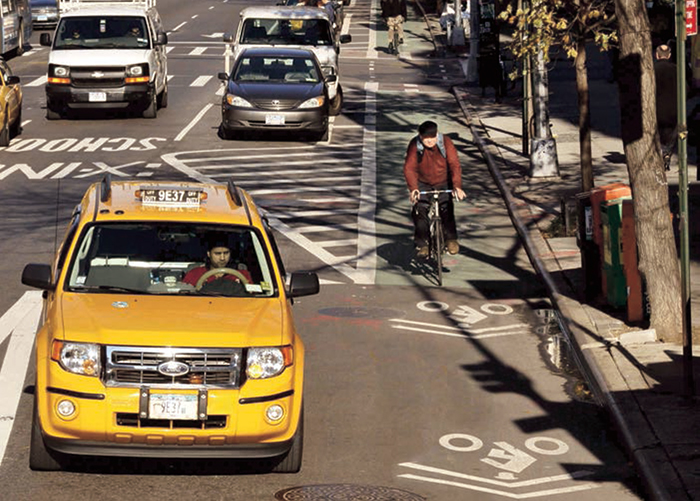
Cycle Track Intersection Approach

NEW YORK, NY
The approach to an intersection from a cycle track should be designed to reduce turn conflicts for bicyclists and/or to provide connections to intersecting bicycle facility types. This is typically achieved by removing the protected cycle track barrier or parking lane (or lowering a raised cycle track to street level), and shifting the bicycle lane to be closer to or shared with the adjacent motor vehicle lane. At these intersections, the experience is similar to a conventional bike lane and may involve similar applications of merging area treatments and markings across intersections. At the intersection, the cycle track may transition to a conventional bike lane or a combined bike lane/ turn lane. Cycle track crossings of signalized intersections can also be accomplished through the use of a bicycle signal phase that reduces conflicts with motor vehicles by separating in time potentially conflicting bicycle and motor vehicle movements.
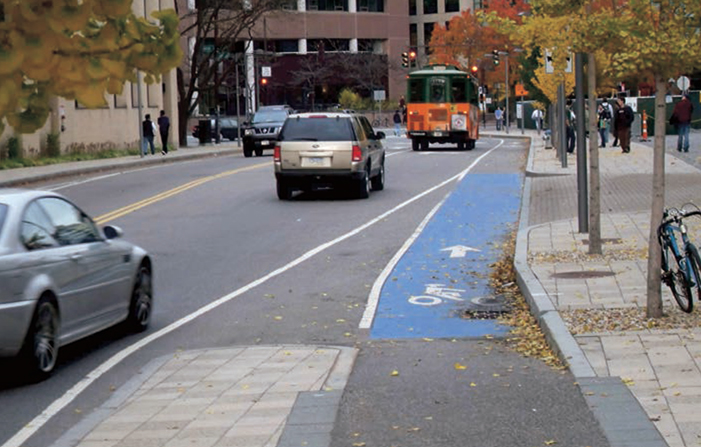
CAMBRIDGE, MA
Benefits
Increases visibility of bicyclists and motorists in advance of the intersection.
Mitigates the risk of “left or right hook” crashes with turning motorists.
May be less expensive than using full bicycle signals.
Encourages motorists to yield to bicyclists when crossing into the narrow right-turn lane.
Reduces motor vehicle speed within the right turn lane.
Typical Applications
Where cycle tracks approach intersections where turning movements across the path of the bicyclist (either left or right) is allowed.
At intersections with a single dedicated right turn lane for motor vehicles.
On cycle tracks protected by on street parking or otherwise removed from the travel lane.
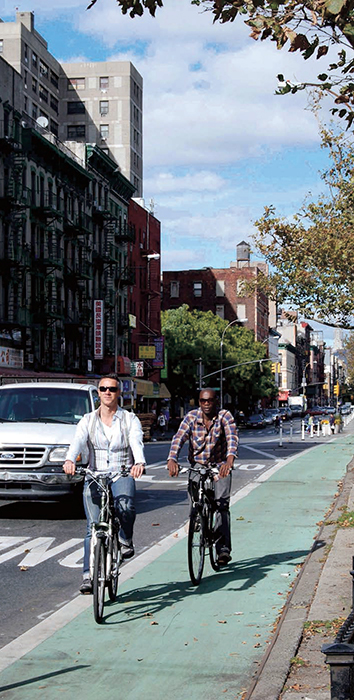
NEW YORK, NY
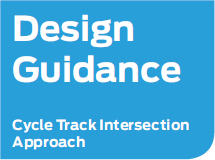
Required Features
 When the cycle track is dropped on an intersection approach, the intersection shall provide some type of bicycle facility to receive cycle track users. This may be a conventional bike lane, bike box, or combined bike lane/ turn lane.
When the cycle track is dropped on an intersection approach, the intersection shall provide some type of bicycle facility to receive cycle track users. This may be a conventional bike lane, bike box, or combined bike lane/ turn lane.
Recommended Features
 For a transition to a bike lane, minimum desirable width is 6 feet, with an absolute minimum of 4 feet. At constrained intersections with right turn lanes, consider transitioning to a mixing zone (combined bike lane/right turn lane.).
For a transition to a bike lane, minimum desirable width is 6 feet, with an absolute minimum of 4 feet. At constrained intersections with right turn lanes, consider transitioning to a mixing zone (combined bike lane/right turn lane.).
 The desirable distance to drop a cycle track prior to an intersection varies by the specific treatment and lane configuration. More space is required when bicyclists and motorists will be mixing or merging.81
The desirable distance to drop a cycle track prior to an intersection varies by the specific treatment and lane configuration. More space is required when bicyclists and motorists will be mixing or merging.81
 Parking should be prohibited 30 to 50 feet in advance of where the cycle track buffer ends to promote visibility between bicyclists and motorists.
Parking should be prohibited 30 to 50 feet in advance of where the cycle track buffer ends to promote visibility between bicyclists and motorists.
 Tactile warnings or pavement markings should be used on slopes from raised cycle tracks to slow bicyclist speed prior to the transition out of the cycle track, and to warn users of potential conflicts with motor vehicles.82
Tactile warnings or pavement markings should be used on slopes from raised cycle tracks to slow bicyclist speed prior to the transition out of the cycle track, and to warn users of potential conflicts with motor vehicles.82
 Cycle tracks should be shifted more closely to the travel lanes on intersection approaches to put bicyclists clearly in the field of view of motorists.
Cycle tracks should be shifted more closely to the travel lanes on intersection approaches to put bicyclists clearly in the field of view of motorists.
 When transitioning from a raised cycle track to street level, the grade should be smooth and comfortable, without significant longitudinal pavement joints or sharp changes in direction. Maximum slope should be 1:8.
When transitioning from a raised cycle track to street level, the grade should be smooth and comfortable, without significant longitudinal pavement joints or sharp changes in direction. Maximum slope should be 1:8.
 Intersection crossing markings should be used with truncated cycle tracks to indicate the intended path of bicyclists through the intersection.
Intersection crossing markings should be used with truncated cycle tracks to indicate the intended path of bicyclists through the intersection.
 Two-stage turn queue boxes should be provided to assist in making turns from the cycle track facility.
Two-stage turn queue boxes should be provided to assist in making turns from the cycle track facility.
Optional Features
 Color may be used to mark conflict areas at intersections with turn lanes, or to extend color applied to the cycle track facility. See Colored Bicycle Facilities for more guidance.
Color may be used to mark conflict areas at intersections with turn lanes, or to extend color applied to the cycle track facility. See Colored Bicycle Facilities for more guidance.
 At intersections with heavy right turn movements, the facility may be combined with a bike box or an advanced stop bar to position bicyclists ahead of motorists.
At intersections with heavy right turn movements, the facility may be combined with a bike box or an advanced stop bar to position bicyclists ahead of motorists.
 At intersection transit stop locations where separate signal control for the cycle track is possible, consider raising the cycle track to sidewalk level and wrapping the cycle track behind the transit stop zone to reduce conflicts with transit vehicles and passengers. Bicyclists should yield to pedestrians in these areas.
At intersection transit stop locations where separate signal control for the cycle track is possible, consider raising the cycle track to sidewalk level and wrapping the cycle track behind the transit stop zone to reduce conflicts with transit vehicles and passengers. Bicyclists should yield to pedestrians in these areas.
 Where separate bicycle signal phase is not possible, an extended mixing zone may be provided with signage directing bicyclists to yield to buses and loading passengers.
Where separate bicycle signal phase is not possible, an extended mixing zone may be provided with signage directing bicyclists to yield to buses and loading passengers.
 Cycle tracks may be configured on the left side of a one-way street to avoid conflicts at transit stops.
Cycle tracks may be configured on the left side of a one-way street to avoid conflicts at transit stops.
 A bicycle exclusive signal phase may be used to segregate conflicting movements between bicyclists and motorists.
A bicycle exclusive signal phase may be used to segregate conflicting movements between bicyclists and motorists.
Adjacent to Right Turn Only Lane
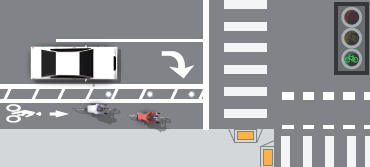
Bicycle Signal Phase
A dedicated bicycle signal phase can eliminate conflict between turning automobiles and bicyclists.
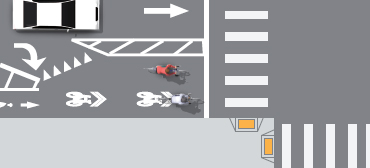
Mixing Zone
A combined bike lane/turn lane encourages motor vehicles and bicyclists to negotiate the space within the travel lane in advance of the intersection.
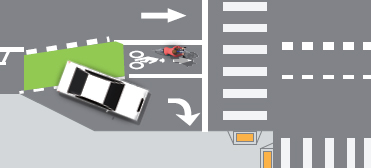
Through Bike Lane
Maintaining the bike lane to the left of a right turn-only-lane positions road users to avoid right-hook collisions.
Lane transitions show here are for illustration purposes only and are not meant to reflect actual design dimensions.
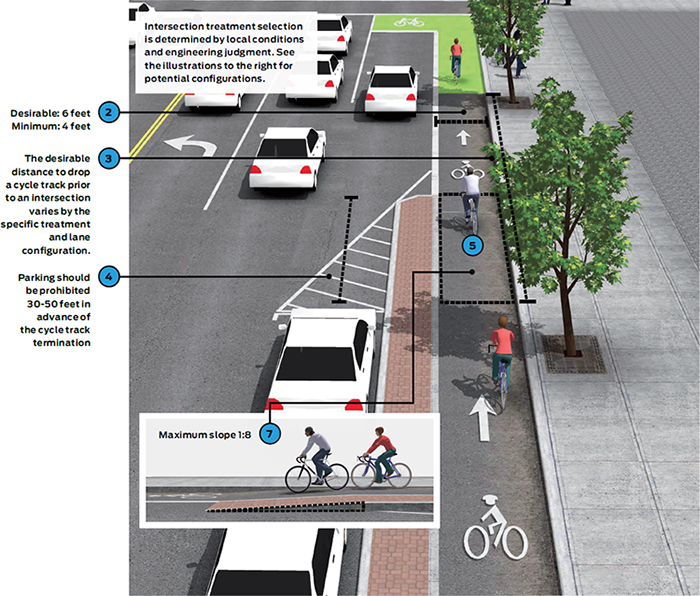
Adjacent to Through/Right Turn Lane
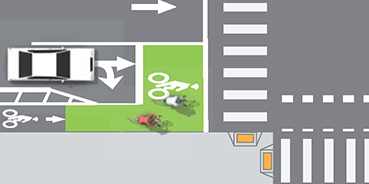
Bike Lane/Bike Box
Positioning bicyclists ahead of automobiles helps prevent right-hook conflicts with turning vehicles at the start of the green indication.
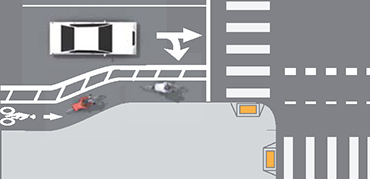
“Bend In” Crossing
Using a curb extension or painted buffer, the cycle track should be bent-in toward the roadway promote visbility of bicyclists in advance of the intersection.
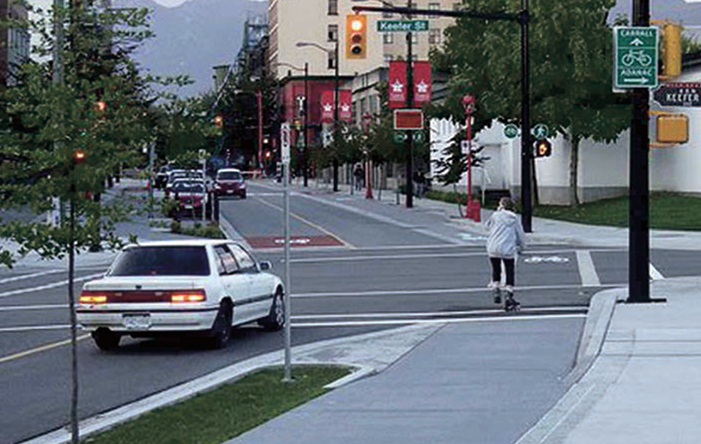
VANCOUVER, BC (WWW.PEDBIKEIMAGES.ORG, CARL SUNDSTROM)
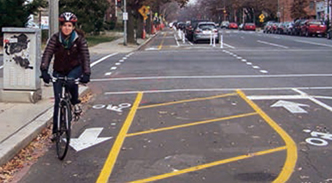
WASHINGTON, DC

MISSOULA, MT
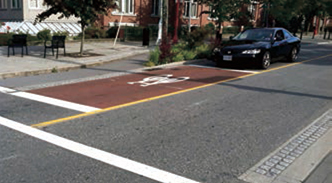
VANCOUVER, BC
Maintenance
Routine roadway/utility maintenance.
Maintaining markings should be a high priority.
Treatment Adoption and Professional Consensus
Commonly used in dozens of European bicycle friendly cities.
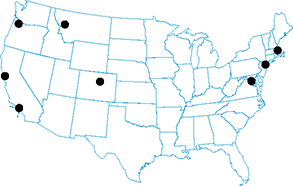
Currently used in the following US cities:
• Cambridge, MA
• Denver, CO
• Long Beach, CA
• Missoula, MT
• New York, NY
• Portland, OR
• San Francisco, CA
• Washington, DC